Crossing at Valhalla: The 2015 Valhalla (USA) Level Crossing Collision
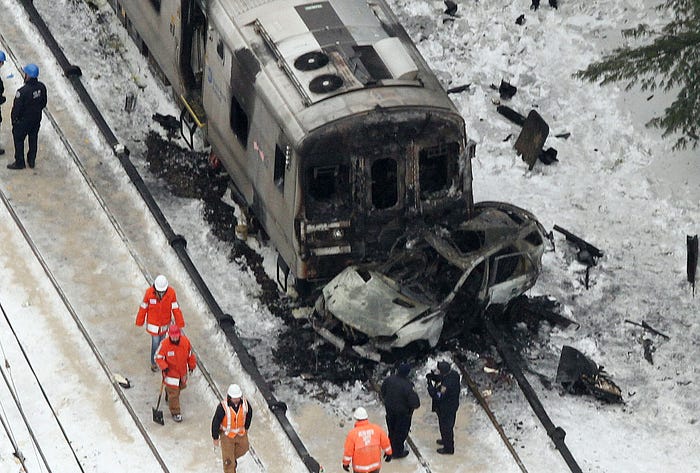
Background
Valhalla is a census-designated area of 3213 people (as of 2020) located 76km/47mi west of New Haven (Connecticut) and 41km/25.5mi north-northeast of New York City in the far southeast of New York State, USA (both measurements in linear distance).
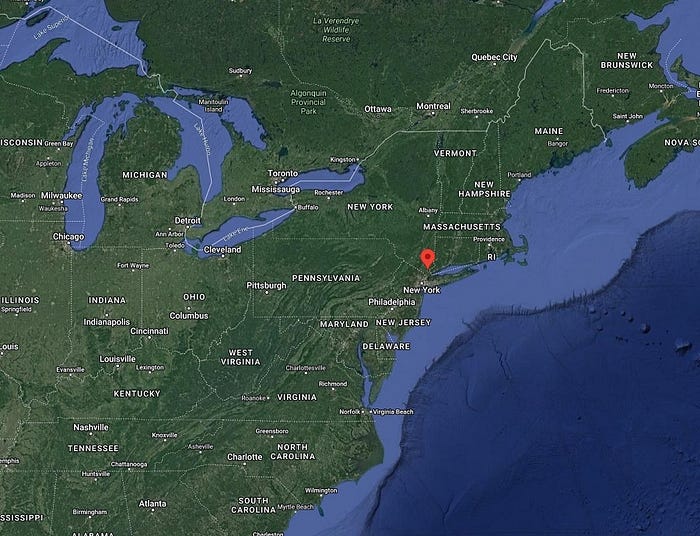
Valhalla lies on the MTA’s (Metropolitan Transportation Authority) Harlem Line, a single-to-quad-tracked mostly electrified commuter rail line connecting New York City’s Grand Central Terminal with Wassaic station further north in Dutchess County. Opening in sections between 1831 and 1871 the 132km/82mi long line serves 38 stations and is almost exclusively used by commuter-trains.
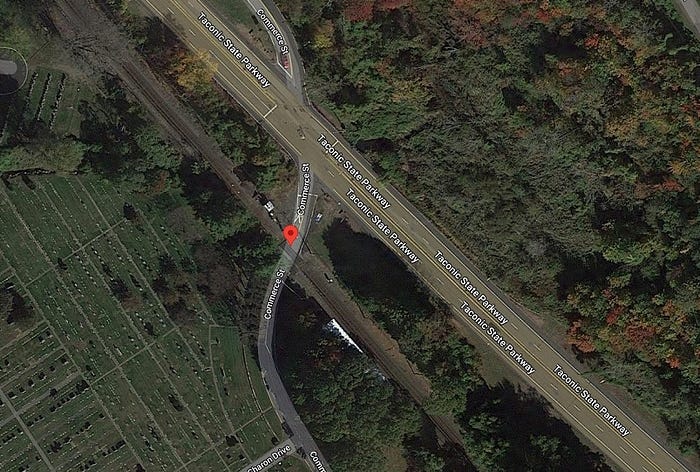
The vehicles involved
Metro-North train 659 was a passenger service from New York City to Wassaic station consisted of 4 two-car Bombardier M7A electric multiple units. Introduced at Metro-North in 2004 each M7A measures 51.81m/170ft in length at a weight of 57.5 metric tons. Each two-car unit has a combined capacity of 211 seated passengers and can reach speeds of as much as 161kph/100mph, but in service doesn’t travel faster than 129kph/80mph. Electricity is provided to the trains from a third rail close to the ground on the left hand side, similar to the New York Subway. Each unit is equipped with flashing lights on the front meant to alert cars and pedestrians at a level crossings to the approaching train. On the day of the accident train 659 was led by car number 4333. At the time of the accident it carried 2 crew-members and 645 passengers, approximately 20 of which were seated in the leading train car.

Travelling northbound on Commerce Street was a black 2011 Mercedes-Benz W166 ML-Class, a midsize SUV introduced in 2011. The car measured 4.83m in length at a weight of approximately 2.2 metric tons and was equipped with an automatic gearbox operated via a stalk on the steering column.
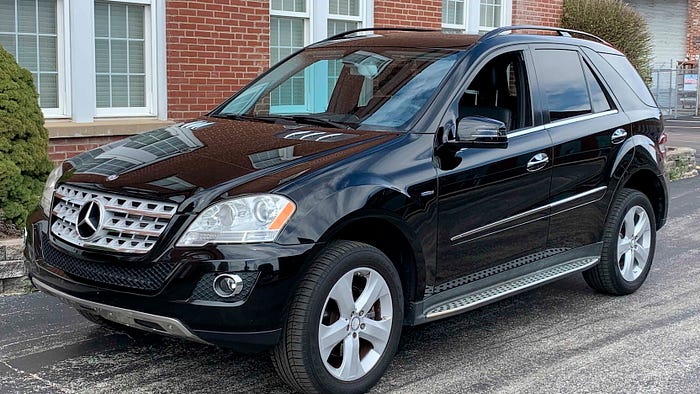
The accident
On the third of February 2015 Miss Brody (49) was travelling southbound on Taconic State Parkway, parallel to the rail line. At 5:25pm an unrelated collision occurred between two cars on the intersection, shutting down the right-hand lane of Taconic State Parkway. The closure forced Miss Brody to turn right into Lakeview Avenue, cross the train tracks and turn right again onto Commerce street. She was now heading north and would cross the rail line again before turning right onto Taconic State Parkway’s left hand lane which would allow her to go around the collision and proceed to her destination at Scarsdale.

Driving behind Miss Brody was Mister Hope, who later stated that Commerce Street was overloaded by the detouring traffic, with cars just inching along in bumper-to-bumper traffic trying to get back onto the Parkway. Cars waiting at the intersection with the Parkway forced traffic on Commerce Street to hold ahead of the level crossing. At approximately 6:23pm Miss Brody stopped the SUV ahead of the train tracks but beyond the level crossing’s stop line. A few seconds later the lights at the crossing came on, followed by the barriers lowering with the southwest barrier ending up on the back of the SUV.
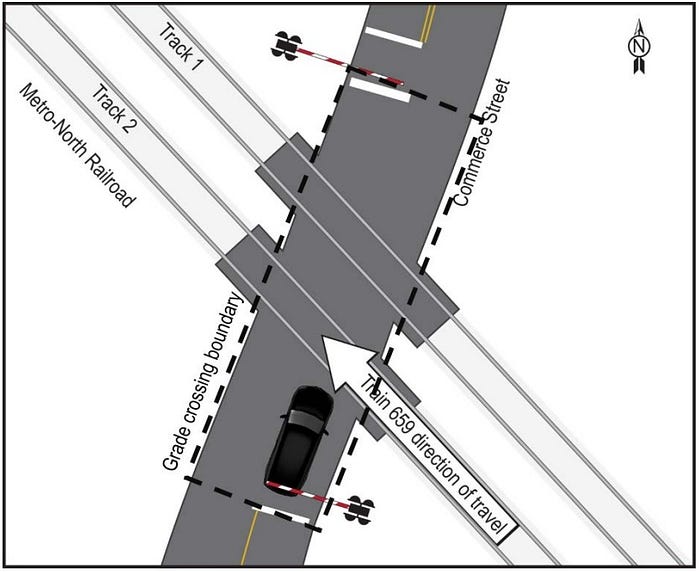
With no car immediately behind it Mister Hope backed his car up a few feet, intending to clear up more space for the SUV to back out of the crossing. He watched as Miss Brody exited her SUV, walking around to the back of it and for unknown reasons touching/pushing on the barrier that had slid off the top of her car and gotten stuck behind it. It seemed like she might have been examining damage or trying to move it, supporting Mister Hope’s theory that the SUV wasn’t actually protruding onto the tracks. Miss Brody made eye contact with him, but didn’t react to his gestures to move to their side of the barrier, with or without the SUV. Instead Miss Brody re-entered the SUV, but instead of backing up the car lurched forwards and was immediately struck by the approaching train, being rammed off the crossing. Hope later said the car was “gone in an instant”.
Mister Smalls, the driver of the train, later told investigators he was approximately 370m/1200ft from the crossing when he saw a reflection in the distance, realizing it stemmed from the nose of the black SUV a few moments later as the front of the car stuck out into the train’s loading-gauge. Mister Smalls sounded his horn and triggered an emergency stop at 95kph/59mph, intending to lessen the consequences of the unavoidable impact before bracing for the imminent impact. As the train was about 85ft from the crossing the SUV lurched forwards, fully into the path of the train. At 6:26:13pm train 659 struck the SUV on its passenger side at 82kph/51mph.
The wreckage of the car ripped the rail line’s third rail off its mounts close to the ground, which pierced through the SUV’s body, penetrating the fuel tank before proceeding to cross through the leading train car’s floor into the interior of the train. The SUV burst into flames as the fuel-tank ruptured, with additional fires starting halfway down the leading train-car. The train and SUV came to a stop 203m/665ft past the crossing, with the SUV and the rear half of the leading train car engulfed in flames. Miss Brody had been killed in the initial collision, with five passengers of the train dying and 15 being injured.

Aftermath
Due to disruptions in the railroad’s electrical system caused by the accident power to the affected section of track wasn’t shut off imediately, with the third rail’s power supply to the east of the crossing shutting off within eight seconds of the collision while the section to the west remained powered up (also still feeding electricity to the rear cars of the train) until being manually shut down 90 seconds later. Mister Smalls escaped the smoke-filled driver’s cab seconds after the train came to a stop, before repeatedly re-entering the burning train to assist in the rescue of passengers. Passengers in the second car initially tried to access the leading car to aid in the rescue, but had to abandon the effort as the fire spread.
The collision had ripped up 140m/450ft of third rail, which had penetrated the leading train car in several sections of 12m/39ft each. Most of the segments became loged in the leading car, with only a few piercing the leading wall of the second car at up to ceiling-level. Five of the victims aboard the train died from blunt force trauma due to being struck by the rail-pieces, a sixth victim’s cause of death couldn’t be determined due to the fire.
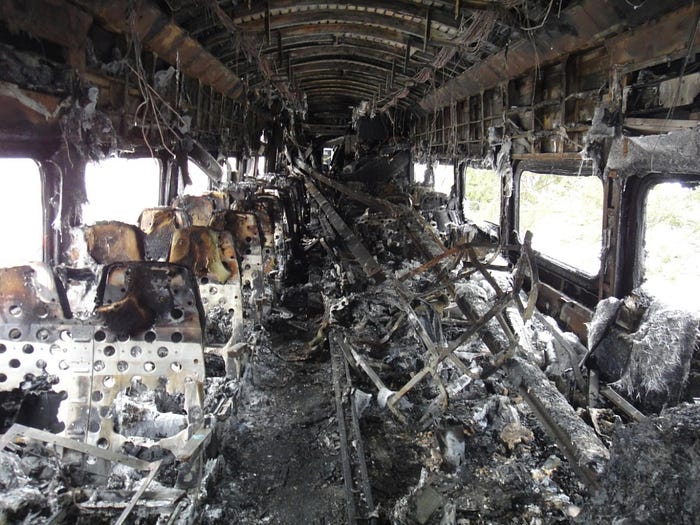
Emergency services were notified at 6:28:08pm, less than two minutes after the collision, and arrived at the site at 6:34:24pm. The fire department arrived to the full car being on fire in its entirety, but managed to keep the flames from engulfing the second car. A triage-area was set up at the level crossing while uninjured passengers were taken to a nearby gym to stay warm before being taken away by bus or taxi cabs. A police helicopter equipped with thermal cameras scanned the nearby cemetery and surrounding area for survivors who wandered off into the night but found none.
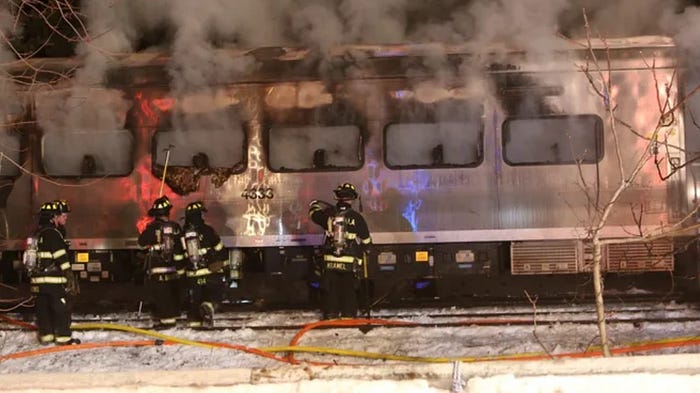
The NTSB (National Transportation Safety Board) opened an investigation into the accident and dispatched investigators to the site hours after the accident took place. They were particularly interested in the unusually high death toll, most level crossing collisions consist of “the train sweeping the car off the tracks” with little consequences for the train’s occupants, especially if the train doesn’t subsequently derail. Another focus of the investigation was the design of the third rail used by Metro-North. While third rail systems are common with US commuter train systems most of them employ a system where a “shoe” on the train maintains contact with the top of the rail, somewhat similar to slot car systems’ power supply. Metro-North uses an under-running system instead, with hook-shaped shoes picking up electricity from the underside of a covered rail. This design has the advantage of better protection from ice-buildup hindering operation as well as making accidental contact with the rail less dangerous. To facilitate this system the ends of the rail after level crossings have a slight wedge-shaped upturn to “catch” the shoe. The third rail is constructed from a rolled steel beam weighing 68kg/150lb per 1m/3ft section and is installed in 12m/39ft sections (which may be shortened during installation if needed). It may be mounted on either side of the track for various reasons as the trains are equipped with pickup-shoes on both sides.
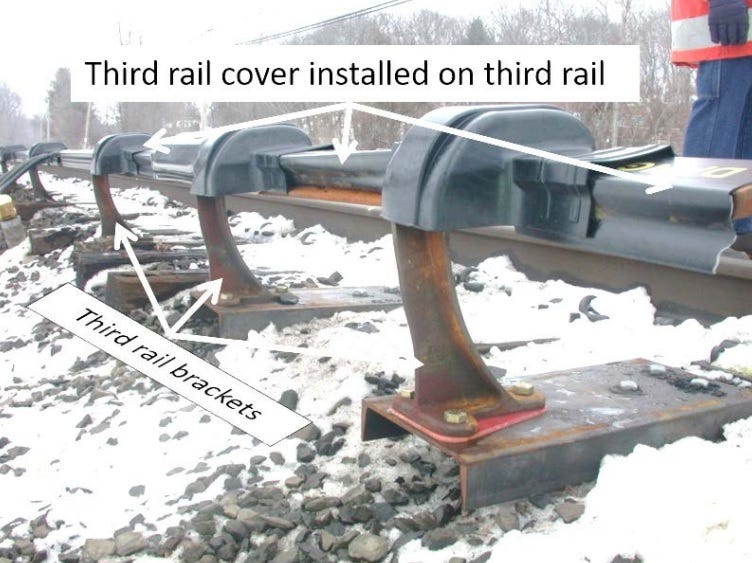

In an interview with NTSB investigators Metro-North’s power director explained that, in his understanding, the third rail system was intended to break away from the train during certain accidents, stating that application of a large force perpendicular to the direction of the tracks breaks them off at the splice-bars between sections. The statement was based on a 1984 collision at Commerce Street’s level crossing where the third rail had broken off and fallen away from the train, reducing damage. Examining the burned wreckage of the train and SUV led investigators to theorize that the third rail had pierced through the SUV (entering underneath the rear seats and exiting behind the right hand rear wheel) on a level path before getting caught in and being forced upwards by the train’s leading bogie. The report mentions the possibility of the under-running design to play a role in this due to their slightly higher position off the ground, but the theory could not be proven since the accident showed too many variables for sensible testing.
The pieces proceeded to penetrate the leading train car in two places, coming through the floor 10ft apart between in the forward section of the leading car. A single piece of third rail proceeded down the entire length of the car, puncturing the second car between the exterior roof and interior ceiling. Lastly, a piece of third rail was found to have jammed the rear door of the leading car, which slowed down the attempts by passengers from car 2 trying to gain access and rescue passengers.

Cellphone records showed that Miss Brody had been talking to her husband until six minutes prior to the accident. While this ruled out the chance of her being distracted by her phone, an ongoing problem in US road traffic, her husband recalled that she seemed to have been unsure of her location at that point already. Residents and regular commuters pointed out that the area around the site of the accident was rather confusing even for locals, with one of them adding that water often pools on the road just a few feet from the crossing, necessitating unusually early braking on the slight downhill approach towards the crossing. However, conditions at the site and Miss Brody’s behavior didn’t support the theory of the SUV sliding into the crossing due to ice buildup. Similarly, statements by her husband about the sleep-cycle in the prior days made excessive fatigue unlikely.

Investigators next acquired an identical SUV and took it to the site of the accident, reenacting the final minutes before the accident with the help of a matching train being positioned on the tracks ahead of the crossing. They found that the train’s horn should have been easy to hear for Miss Brody inside the car, even if she had the heater or radio turned on, but also figured out that, after stepping out of the SUV, the vehicle and a nearby substation would have obscured a large part of the train’s approach. It was theorized that after she heard the barrier hitting the new-to-her car (purchased 2 months prior to the accident) her focus may have been on possible damage to the car from being hit by the barrier. This distraction, on top of being in an unknown location in the dark, likely consumed much of her attention, aided by the car and substation obscuring the approaching train and, in a somewhat tragic irony, the headlights and gestures from surrounding cars. Furthermore, according to statements by Mister Hope and Mister Smalls, the SUV wasn’t actually on the tracks until right before impact, meaning if Miss Brody looked down at any point while standing at the rear of her car she’d see tarmac, not train tracks.
The report also notes that the version of the SUV used by both Miss Brody and the investigators is equipped with a shifter mounted on the right side of the steering column instead of the conventional position between the front seats. While the car Miss Brody had been driving until the purchase of the SUV 2 months before the accident had had the shifter in the conventional spot her Husband didn’t recall her mentioning any difficulty with the new system, finding it easy to get used to himself.
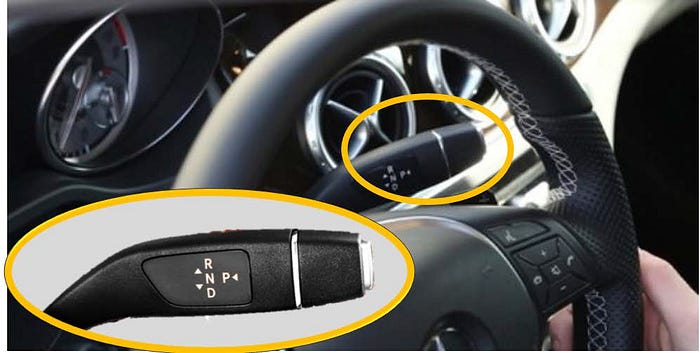
Unable to find a certain answer the investigation placed sole blame for the accident on Miss Brody, based on the theory that she rolled into the crossing by accident and was initially distracted by the barrier hitting her car, aided by the position of her car relative to the approaching train obscuring the latter. She likely eventually realized that she was in a level crossing, not necessarily noticing the approaching train, and attempted to vacate the crossing by driving forwards as she was “blocked in” by the barrier behind her car. This, tragically, put her right in the path of the train with no chance for the train driver to do anything. It is possible that she never realized how close the train was to her car.
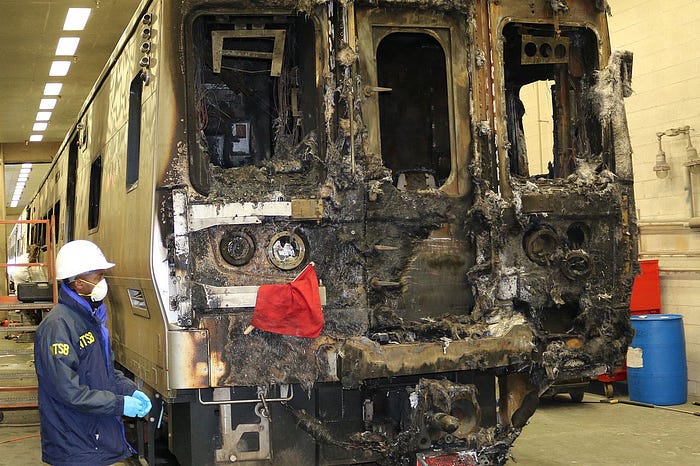
Investigators still had to explain the fatal fire inside the train, which, while not responsible for at least five of the six deaths aboard the train, still played a major factor in the accident. Examinations of the third rail pieces recovered from the leading train car showed no sign of electrical arching, the most likely cause of a fire in a scenario like this. The most likely scenario was that the fire started as the third rail ruptured the SUV’s fuel tank, spraying fuel across hot metal and possible sparks as well as spreading along the tracks below the train. The report poses the theory that the third rails entered the rail car partially ablaze due to being covered in fuel and burning debris, with the holes they left allowing further access for the flames. A major part in the escalation of the fire was blamed on the cover of the third rail, which is made of polymer-based plastic and obviously ignited during the fire, melting and sticking to various surfaces.
Passengers in the center and rear were able to evacuate through emergency exits, substituting the jammed door at the rear of the train car. This prevented further injury and deaths among the passengers, with the report again emphasizing that none of the fatalities could be blamed on the fire, with one being of uncertain cause and the rest due to blunt force trauma.

With the first car’s interior burned beyond recognition investigators proceeded by taking samples of the second car’s seat upholstery, wall panels and light fixtures to examine their behavior when exposed to heat and fire. The materials all had passed fire deceleration tests and met required standards upon their introduction in 2000, but testing after the accident showed that the materials failed to meet the same standards now. Specifically, materials taken from the upholstery, seat-back/bottom (a single-piece shell) and cushioning failed to meet the federal standards. However, the regulations do not require repeat testing, only a single test upon introduction needs to be passed. The cushioning of the backrests, a different material than the seat-cushion, still complied with the regulations. Furthermore, survivors stated that the fire still spread slowly and didn’t significantly hinder the evacuation.
The report was published in July 2017, placing sole blame on Miss Brody and citing distractions as the main cause of the accident. Three members of the four-person investigative team filed individual statements to go with the report, while two statements agreed with the report a third statement dissented the findings. Mister Weener criticized the speculation on Miss Brody’s motive, agreeing that she must have lost situational awareness but criticized the “wild guessing” about the reason for that. He further addressed issues he felt the investigation should have considered more thoroughly, saying:
I am left unsatisfied as to how the configuration of this angled crossing, the signage approaching the crossing, the deterrent effect of existing New York rail crossing statutes, and the New York State driver education regarding rail crossing safety may have affected these events.”
He further questioned if the general population was sufficiently informed about railway barriers being designed to break away easily, a commonly assumed knowledge-gap with people seemingly expecting at least severe damage to their vehicles if they attempt to break through lowered barriers.

In the months after the accident 34 different claims were filed against the railway company as a first step towards lawsuits, mostly from survivors or the families of victims, including the Brody family. Their lawyer alleged that money allocated for a 2009 improvement should have been used to bring the crossing signage up to federal standards was never spent while the widow of Robert Dirks, a famous chemist, filed claims against the town, county, Metro North and Mister Smalls. She argued that Smalls had evidently sounded the horn for five seconds before triggering an emergency stop, meaning he could’ve arranged for a slower collision with possibly less severe consequences. Mister Smalls argued in return that he acted in accordance with his training, which instructs drivers to not use emergency stops as a first resort due to the risk of injuring especially standing passengers aboard their trains.
In 2018 it was disclosed that Mister Smalls had reached an undisclosed settlement of a legal claim he had made against the local transit authority and had never returned to work as the accident had caused him to suffer from post-traumatic stress disorder. Attorneys involved in the ongoing lawsuits accused the transit authority of “buying his silence” as Mister Smalls withdrew from any further legal action in relation to the accident. By 2019 several lawsuits were still ongoing, with the focus having largely shifted to the choice and design of the third rail as several plaintiffs, including Miss Brody’s widower, disagreeing with the NTSB placing sole blame on her actions.
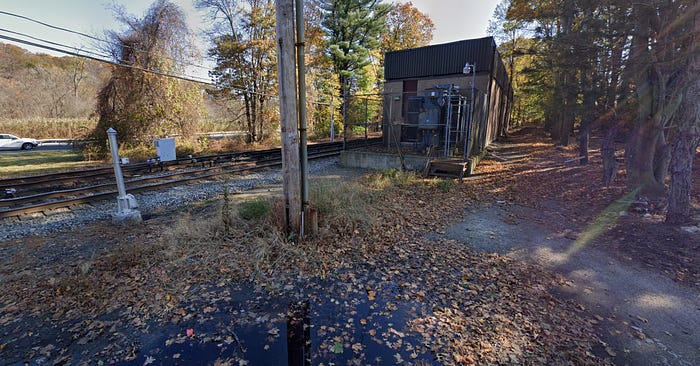
After the accident the subject of removing the level crossing entirely was extensively discussed as it met several of the Federal Highway Administration’s criteria for closing level crossings. A study by the town engineer showed that removal of the crossing and changes to the surrounding roads and signage would cost a tenth of the damages the town might be assessed to pay despite being rather unable to prevent it, a scenario that could repeat anytime. The plan to shut down both the level crossing where the accident happened and a further one in the center of the town received further traction when the report published with the recommendation to close the crossing due to several risk-factors (including the short distance to traffic lights, the unfortunate angle to the tracks and the high train-frequency). However, residents protested heavily and eventually the vote came out in favor of keeping the crossing operational. By September 2016 it was announced that the crossing along with 42 others would be fitted with surveillance cameras to improve operational safety.
In the months following the accident the transit authority started a large-scale campaign to promote awareness for level crossing safety, featuring a dedicated website, several posters and billboards as well as videos shown at train stations and on social media. Additional videos were shown at cinemas ahead of various movies. The campaign was supplemented by a cooperation with the local police departments, having officers hand out pamphlets and speak to pedestrians at level crossings. By November 2016 the officers had issued a number of summonses to violators of the law and even arrested five people who ignored closed crossings.
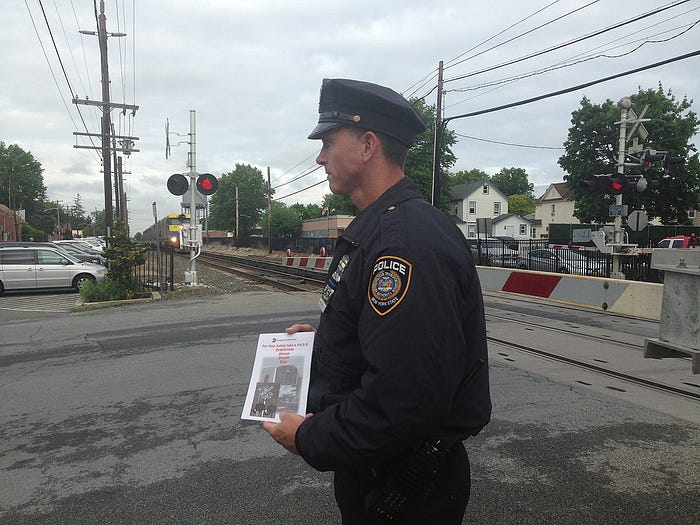
The leading train car was scrapped after the investigation concluded, with its partner-car being stripped for spares before being scrapped as well. The remaining units are still in full service, with no date of retirement in sight as they enjoy high degrees of reliability in daily operations. The collision was the first of four significant accidents involving the type and remains the USA’s second deadliest rail accident in recent history, being surpassed by the Philadelphia Train Derailment claiming 8 lives three months after this accident. Level crossing accidents even on secured crossings (barriers lowering to block the road) remain an ongoing problem around the world despite regular efforts to raise awareness about the dangers posed by a level crossing.
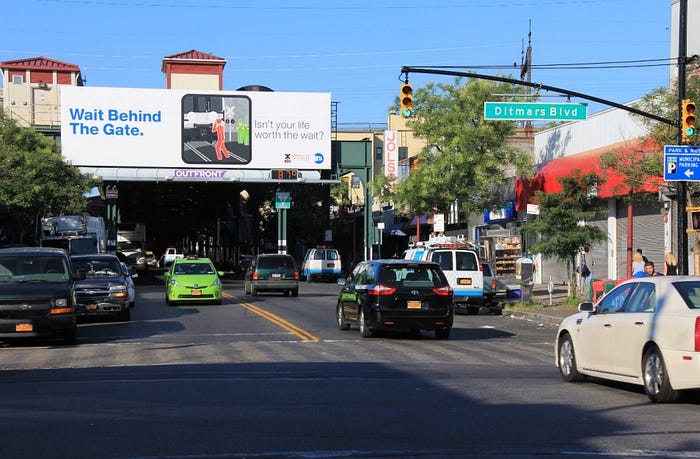
_______________________________________________________________
